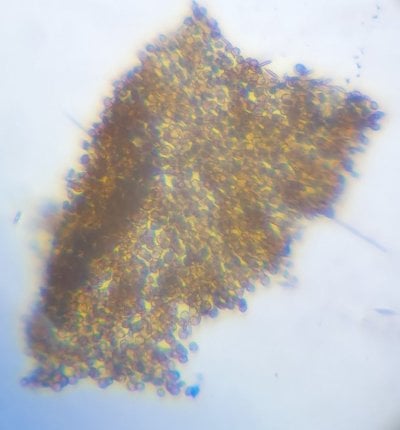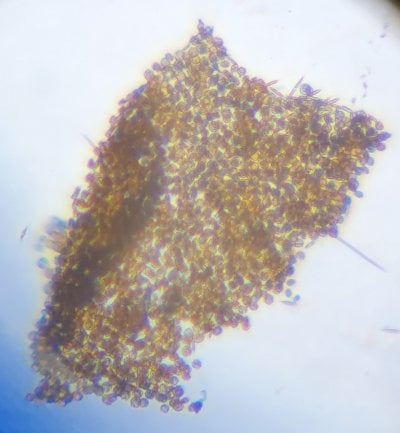Navigation
Install the app
How to install the app on iOS
Follow along with the video below to see how to install our site as a web app on your home screen.
Note: This feature may not be available in some browsers.
More options
You are using an out of date browser. It may not display this or other websites correctly.
You should upgrade or use an alternative browser.
You should upgrade or use an alternative browser.
Dinoflagellates – Are You Tired Of Battling Altogether?
- Thread starter mcarroll
- Start date
- Tagged users None
I think it was mentioned way earlier in this thread but can’t remember. But has anybody thought about why these Dino blooms have become a problem in the past several years. I’ve been keeping saltwater tanks for decades, mainly low nutrient SPS systems and don’t remember them ever being a problem in the past but now out of nowhere they seem to be.
The only way I can keep them at bay in my tank now is with intense UV. Once that is disconnected they slowly come back.
The only way I can keep them at bay in my tank now is with intense UV. Once that is disconnected they slowly come back.
There are many speculations I've seen on this and other threads. I think there are multiple potential answers that can fit different scenarios. In fact you probably need to compound a few things together to allow these edge consumers to proliferate.I think it was mentioned way earlier in this thread but can’t remember. But has anybody thought about why these Dino blooms have become a problem in the past several years. I’ve been keeping saltwater tanks for decades, mainly low nutrient SPS systems and don’t remember them ever being a problem in the past but now out of nowhere they seem to be.
The only way I can keep them at bay in my tank now is with intense UV. Once that is disconnected they slowly come back.
Take this VERY common example of reefing today:
a) Starting a system with dead rock and bacteria in a bottle AND...
b) Running GFO with a refugium and skimmer while targeting .02 of PO4 and .25 nitrates AND...
c) Dosing amino acids AND...
d) Dosing Chemiclean for cyano
How many people were doing all four things 10 years ago? Not many.
I am a bit two minded need about this.I think it was mentioned way earlier in this thread but can’t remember. But has anybody thought about why these Dino blooms have become a problem in the past several years. I’ve been keeping saltwater tanks for decades, mainly low nutrient SPS systems and don’t remember them ever being a problem in the past but now out of nowhere they seem to be.
The only way I can keep them at bay in my tank now is with intense UV. Once that is disconnected they slowly come back.
My incite is no way relevant as I had no saltwater aquarium in the past I was always found of African cichlids in the last almost 40 years and dinos were less of a concern but as an IT I definitely see a trend of people have more awareness of things than before.
We have more information coming towards to us and if we have interest in some topic we will get huge amount of articles available just a click away. (Many written by self elected experts - but that is a complete new topic)
I personally believe the issue is more likely just more exposed than before and in the past it was running under one of the uglies. This would put me to the NO side.
But i also can imagine some of the regulations forced the aquarium trade to change and the aquarists to go down the dry rock route where many of the processes become more long winded than before and biodiversity is lower therefore Dinos have more chance surface as a problem. Now this is a YES.
Now the question is if this really matters?
- Joined
- Apr 3, 2017
- Messages
- 281
- Reaction score
- 207
Can anybody help with this? I've been struggling with these fellas for a while.
Sorry for the useless pics/vids, this is taken at 1200x magnification and my cheap microscope is a bit fiddly to use on that setting. The brown snot looked to be about 95% these tiny ones, with the ocassional much bigger one swimming about. The tiny ones are pretty much static.
The cause i believe was accidentally dropping nitrate and phosphate to near zero with the 'fuge lights being on for too long.
Video:
Sorry for the useless pics/vids, this is taken at 1200x magnification and my cheap microscope is a bit fiddly to use on that setting. The brown snot looked to be about 95% these tiny ones, with the ocassional much bigger one swimming about. The tiny ones are pretty much static.
The cause i believe was accidentally dropping nitrate and phosphate to near zero with the 'fuge lights being on for too long.
Video:
Attachments
Can anybody help with this? I've been struggling with these fellas for a while.
Sorry for the useless pics/vids, this is taken at 1200x magnification and my cheap microscope is a bit fiddly to use on that setting. The brown snot looked to be about 95% these tiny ones, with the ocassional much bigger one swimming about. The tiny ones are pretty much static.
The cause i believe was accidentally dropping nitrate and phosphate to near zero with the 'fuge lights being on for too long.
Video:
That is the most camera shy dino I have ever not seen. Based on movement I'd guess you have a very lonely LC amphidinium.
The small static stuff is a bit more puzzling. How old is tank?
Dosing up NO3 and PO4 never hurts much. At this point I would not invest in a UV.
Keep taking some sample photos as I personally don't yet have a high conviction ID.
- Joined
- Apr 3, 2017
- Messages
- 281
- Reaction score
- 207
Hi Scott, thanks for your reply, much appreciated.That is the most camera shy dino I have ever not seen. Based on movement I'd guess you have a very lonely LC amphidinium.
The small static stuff is a bit more puzzling. How old is tank?
Dosing up NO3 and PO4 never hurts much. At this point I would not invest in a UV.
Keep taking some sample photos as I personally don't yet have a high conviction ID.
The tank is about 3 months old and these things have been present since the start. All the rock etc was new but i moved some coral from my old tank which also had the same dino so i most likely introduced it.
I will keep trying to photograph them.
I'm not convinced they leave the and at night but have ordered some fine filter socks (5 micron) to see if there is any improvement.
If i keep the p&n levels up, is it sensible to dose Vibrant?
Oh. I forgot to ask that standard question about system age. It is almost mandatory that new tanks need to cycle through a bunch of ugly phases. Diatoms, euglena, chrysophytes, various algae forms, some dinos, then a different algae, some cyano, on and on. Until the system just reaches stasis with a blend of bacterial film, film algae, coralline algae, etc.Hi Scott, thanks for your reply, much appreciated.
The tank is about 3 months old and these things have been present since the start. All the rock etc was new but i moved some coral from my old tank which also had the same dino so i most likely introduced it.
I will keep trying to photograph them.
I'm not convinced they leave the and at night but have ordered some fine filter socks (5 micron) to see if there is any improvement.
If i keep the p&n levels up, is it sensible to dose Vibrant?
Keep a little nutrient available, stick with your WC and husbandry routine as it goes through these processes. A lot of intervention at this point just prolongs the process IMO. Not incredibly satisfying advice I know, but stay patient with it.
This was reassuring for me as I sit and stare at my 3 month old tank that has a mix of cyano and a few spots of dino's. dry rock start with bacteria bottle. Recently realized my nutrients were Nitrates at 4 and my phosphate was at zero. Going to start feeding more and slowly raising nutrients and just see how things play out for now.Oh. I forgot to ask that standard question about system age. It is almost mandatory that new tanks need to cycle through a bunch of ugly phases. Diatoms, euglena, chrysophytes, various algae forms, some dinos, then a different algae, some cyano, on and on. Until the system just reaches stasis with a blend of bacterial film, film algae, coralline algae, etc.
Keep a little nutrient available, stick with your WC and husbandry routine as it goes through these processes. A lot of intervention at this point just prolongs the process IMO. Not incredibly satisfying advice I know, but stay patient with it.
You can shorten up the uglies phase a bit by adding more diversity from other, older systems. Some sump rock, sand, mud.This was reassuring for me as I sit and stare at my 3 month old tank that has a mix of cyano and a few spots of dino's. dry rock start with bacteria bottle. Recently realized my nutrients were Nitrates at 4 and my phosphate was at zero. Going to start feeding more and slowly raising nutrients and just see how things play out for now.
But yeah, your biome will be "noisy" for 9-12 months as one competitor defeats another. Keep the basics (temp, salinity, a little nutrient) stable.
- Joined
- Apr 3, 2017
- Messages
- 281
- Reaction score
- 207
Oh. I forgot to ask that standard question about system age. It is almost mandatory that new tanks need to cycle through a bunch of ugly phases. Diatoms, euglena, chrysophytes, various algae forms, some dinos, then a different algae, some cyano, on and on. Until the system just reaches stasis with a blend of bacterial film, film algae, coralline algae, etc.
Keep a little nutrient available, stick with your WC and husbandry routine as it goes through these processes. A lot of intervention at this point just prolongs the process IMO. Not incredibly satisfying advice I know, but stay patient with it.
Thank you.
I can't face leaving it though. I had (what i think is) the same type in my previous two tanks, and never completely eradicated them in at least 5 years.
Since the dinos seem to stay within the substrate at night, I was thinking of trying silica dosing (combined with keeping nutrients up). As I understand it, there isn't too much risk to this.
Obviously though there is something wrong with the way I run my tanks. Probably they are understocked or I underfeed. I will be vigilant in keeping nutrients sensible.
- Joined
- Oct 25, 2018
- Messages
- 650
- Reaction score
- 1,105
Okay so it's probably been two months since the last signs of dinos but I think I've got it beat (for now). I bet what fixed it was putting in rock and sand from the ocean, no water changes, and dosing nitrates and phosphates constantly for MONTHS. I knew it was getting better when the barely alive pulsing xenia was starting to fluff back up. Now my nutrients are about the same level as in the ocean. The corals all look great (except for the gorgonian, had to frag it because of tissue necrosis, but the pieces are alive and look okayish so yay I guess).
Diversity is not a quick fix, but I am convinced it is a necessary part of the solution. Just don't let nutrients disappear on you.Okay so it's probably been two months since the last signs of dinos but I think I've got it beat (for now). I bet what fixed it was putting in rock and sand from the ocean, no water changes, and dosing nitrates and phosphates constantly for MONTHS. I knew it was getting better when the barely alive pulsing xenia was starting to fluff back up. Now my nutrients are about the same level as in the ocean. The corals all look great (except for the gorgonian, had to frag it because of tissue necrosis, but the pieces are alive and look okayish so yay I guess).
I can't seem to get a better picture with my iPhone. I used to have just one type of Dino visible...Are there more than one variety here?

Dino type?
Dino type?
- Joined
- Sep 21, 2019
- Messages
- 84
- Reaction score
- 107
Is this Dino? Please help. It’s getting bad.
Attachments
-
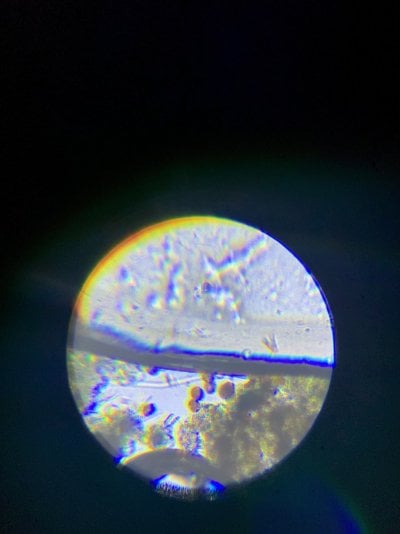 FB267A74-0E51-4F73-91C1-B7F884C8F68F.jpeg112 KB · Views: 62
FB267A74-0E51-4F73-91C1-B7F884C8F68F.jpeg112 KB · Views: 62 -
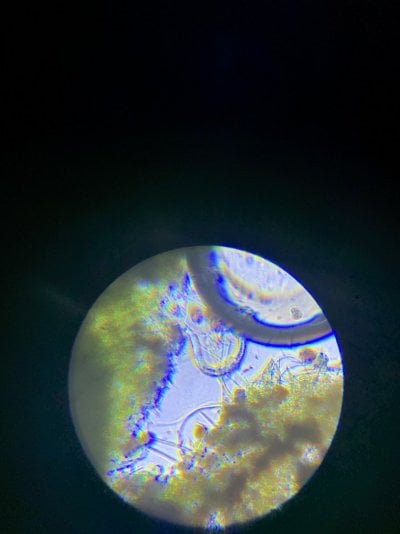 2900E845-AB49-4C43-A000-B888C18BE42C.jpeg113.5 KB · Views: 53
2900E845-AB49-4C43-A000-B888C18BE42C.jpeg113.5 KB · Views: 53 -
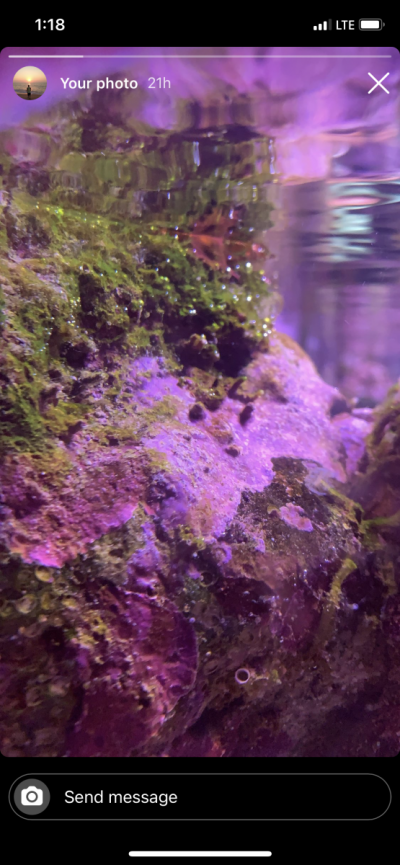 DDA2857F-D15F-4AD2-885B-D9BCF9900002.png977.3 KB · Views: 56
DDA2857F-D15F-4AD2-885B-D9BCF9900002.png977.3 KB · Views: 56 -
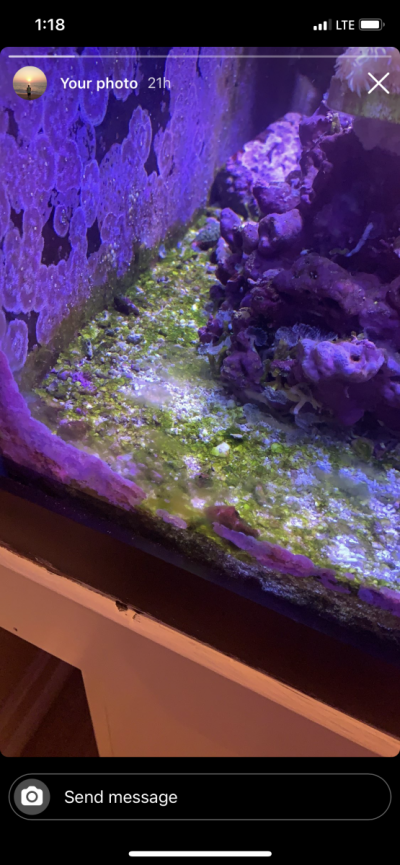 158163FF-E08C-45D7-B071-C761E180B42F.png952 KB · Views: 62
158163FF-E08C-45D7-B071-C761E180B42F.png952 KB · Views: 62 -
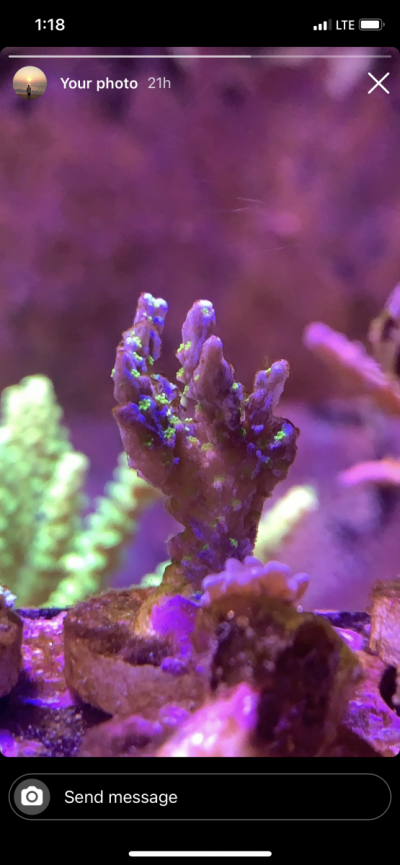 E2092532-3757-4207-B034-BCDCB6334DF2.png803.8 KB · Views: 57
E2092532-3757-4207-B034-BCDCB6334DF2.png803.8 KB · Views: 57
- Joined
- May 22, 2016
- Messages
- 6,970
- Reaction score
- 10,747
video shows just prorocentrum.I can't seem to get a better picture with my iPhone. I used to have just one type of Dino visible...Are there more than one variety here
diatom (probably licmophora) partyWhat are these???
That was my default position. That people generally weren't microscope IDing this stuff back then, so it's an issue of more awareness and better diagnosis.I personally believe the issue is more likely just more exposed than before and in the past it was running under one of the uglies. This would put me to the NO side.
But I wasn't in the hobby back then, and there are a lot of people who were and are reliable sources of information that I find to be accurate in every other context, and they say that dinos now are occurring on a much wider scale and with much increased frequency.
Thanksvideo shows just prorocentrum.
diatom (probably licmophora) party
That was my default position. That people generally weren't microscope IDing this stuff back then, so it's an issue of more awareness and better diagnosis.
But I wasn't in the hobby back then, and there are a lot of people who were and are reliable sources of information that I find to be accurate in every other context, and they say that dinos now are occurring on a much wider scale and with much increased frequency.
What do you use to look this stuff up? I tried googling, but Im new at the whole "what is this microscopic thing" search structure. It was like finding a needle in a needle stack.
- Joined
- May 22, 2016
- Messages
- 6,970
- Reaction score
- 10,747
@joshwaggs
single best resource for algae is phycokey
use it as a starting place, then you can get a genus name (or sometimes species) and google image search.
It's daunting at first until you see the patterns and can fairly quickly look at one or two families and get where you're going.
Random microalgae in reef tanks are 95% cyano, diatoms, dinoflagellates. 5% "other" fun tiny weird things.
single best resource for algae is phycokey
use it as a starting place, then you can get a genus name (or sometimes species) and google image search.
It's daunting at first until you see the patterns and can fairly quickly look at one or two families and get where you're going.
Random microalgae in reef tanks are 95% cyano, diatoms, dinoflagellates. 5% "other" fun tiny weird things.
Been dosing silicates, and my diatom population is increasing....See attached picture. Do I keep dosing silicates? When do I leave it alone?

Similar threads
- Replies
- 43
- Views
- 544
- Replies
- 1
- Views
- 90
- Replies
- 4
- Views
- 252





